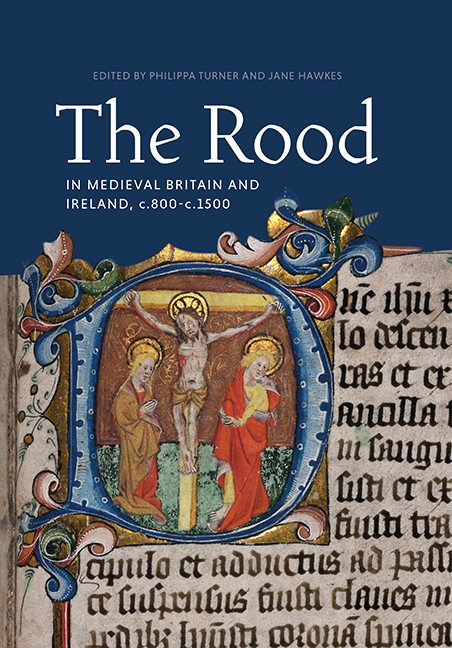Book contents
- Frontmatter
- Contents
- List of Illustrations
- List of Contributors
- Acknowledgements
- List of Abbreviations
- 1 Introduction: Rethinking the Rood
- 2 Approaching the Cross: The Sculpted High Crosses of Anglo-Saxon England
- 3 The Mark of Christ in Wood, Grass and Field: Open-Air Roods in Old English Medical Remedies
- 4 Twelfth-Century English Rood Visions: Some Iconographic Notes
- 5 Crosses, Croziers and the Crucifixion: Twelfth-Century Crosses in Ireland
- 6 From Religious Artefacts to Symbols of Identity: The Role of Stone Crosses in Galician National Discourse
- 7 The Rood in the Late Medieval English Cathedral: The Black Rood of Scotland Reassessed
- 8 The Cross of Death and the Tree of Life: Franciscan Ideologies in Late Medieval Ireland
- 9 Heralding the Rood: Colour Convention and Material Hierarchies on Late Medieval English Rood Screens
- 10 Reframing the Rood: Fifteenth-Century Angel Roofs and the Rood in East Anglia
- Bibliography
- Index
- Already Published
- Plate Section
5 - Crosses, Croziers and the Crucifixion: Twelfth-Century Crosses in Ireland
Published online by Cambridge University Press: 07 November 2020
- Frontmatter
- Contents
- List of Illustrations
- List of Contributors
- Acknowledgements
- List of Abbreviations
- 1 Introduction: Rethinking the Rood
- 2 Approaching the Cross: The Sculpted High Crosses of Anglo-Saxon England
- 3 The Mark of Christ in Wood, Grass and Field: Open-Air Roods in Old English Medical Remedies
- 4 Twelfth-Century English Rood Visions: Some Iconographic Notes
- 5 Crosses, Croziers and the Crucifixion: Twelfth-Century Crosses in Ireland
- 6 From Religious Artefacts to Symbols of Identity: The Role of Stone Crosses in Galician National Discourse
- 7 The Rood in the Late Medieval English Cathedral: The Black Rood of Scotland Reassessed
- 8 The Cross of Death and the Tree of Life: Franciscan Ideologies in Late Medieval Ireland
- 9 Heralding the Rood: Colour Convention and Material Hierarchies on Late Medieval English Rood Screens
- 10 Reframing the Rood: Fifteenth-Century Angel Roofs and the Rood in East Anglia
- Bibliography
- Index
- Already Published
- Plate Section
Summary
TWELFTH-CENTURY IRISH CROSSES
Although the term ‘rood’ does not appear in the early Irish sources, we have substantial evidence that devotion to the cross was expressed in many forms in medieval Ireland, just as it was overseas. The cult of the True Cross played a role as early as the seventh century, remaining relevant for hundreds of years afterwards. In Irish poetry, hagiography, liturgy and history, we find references to the word ‘cros’ in a variety of contexts. In works of art, too, we see images of the crucified Christ, and the cross itself, in almost every medium. By the twelfth century in Ireland, we also find depictions of figures holding croziers, which are not cruciform in and of themselves but can be associated with cross-bearers by nature of their function as staffs of ecclesiastical office. In fact, church leaders in Ireland had wielded staffs as insignia of power since the time of St Patrick, who according to legend, was miraculously given the Bachall Iosa (Staff of Jesus) by Christ himself. A spectacular processional-reliquary cross also survives: the so-called Cross of Cong, made in the 1120s to house a fragmentary relic of the True Cross (Plate V).
These images of crosses, croziers and the crucifixion visualise the complex network of ideas circulating in the areas of theology, politics and Church reform during the long Irish twelfth century (c. 1014‒1169). They share stylistic elements with works of art from abroad, demonstrating Ireland's connectedness with the medieval world beyond its shores. They include iconographies that reinforce Ireland's participation in contemporary church reform movements, a trend toward institutional changes that was already underway within the country prior to external interventions. And, they utilise the form of the cross in a variety of ways to proclaim and assert power structures, both sacred and secular.
Below, I consider three examples of twelfth-century Irish art that involve the notion of the cross: a relief carving of the crucifixion on the Market Cross at Tuam, Co. Galway (Figs 5.1 and 5.2), the elaborate reliquary mentioned above, the Cross of Cong (Plate V) and a relief carving of several ecclesiastical personages on the so-called ‘Doorty’ Cross from Kilfenora, Co. Clare (Fig. 5.4).
- Type
- Chapter
- Information
- The Rood in Medieval Britain and Ireland, c.800-c.1500 , pp. 59 - 80Publisher: Boydell & BrewerPrint publication year: 2020



